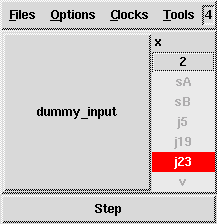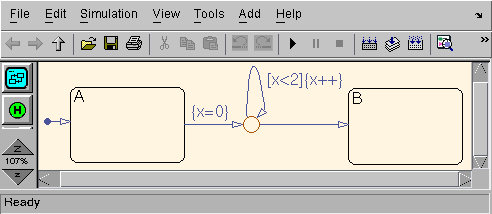
Figure 4: A Stateflow chart with a junction loop



The Stateflow chart shown in Figure 4 (Loops1_docs.mdl) with an observer has a junction loop, the transition labelled
Figure 4: A Stateflow chart with a junction loop
[x<2]{x++} initiates a loop in the network.
Strictly speaking, we cannot arbitrarily translate this chart into Lustre as
it stands since Lustre is compiled into a stackless machine and without a
stack it is not possible to implement arbitrary recursion within a
reaction.
If we try to translate this chart we get:
% sf2lus Loops1.mdl -o Loops1.lus
Fatal error: exception Failure("Loops found in links")
Detecting loops is trivial. There are two possibilities:
-junc_states option:
% sf2lus -names -states_visible -junc_states Loops1.mdl -o Loops1.lusThis results in the following sequence when simulated with Luciole:
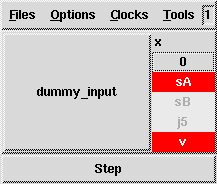
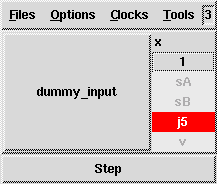
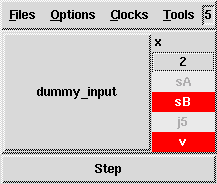
v has been synthesized (or valid with
-full_names) which indicates when the chart is in a state and not a
junction.
In theory arbitrary recursion could be implemented this way, passing the burden
of termination to the client code but it is not a very satisfactory solution.-counters option to maintain counters on each junction:
% sf2lus -names -states_visible -junc_states -counters \
Loops1.mdl -o Loops1.lus
After Luciole simulation we get: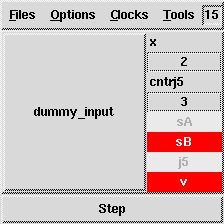
cntrlim=3in the ``Description'' field. With this annotation in place, the
-counters option will also cause the
translator to output the following observer for the loop counters.
The observer node name is comprises loop_counters_<CID> where
<CID> is the chart id number as for the toplevel Stateflow:
-- Observer for junction loop counters node loop_counters_2(dummy_input: bool) returns(prop: bool); var x, cntrj5: int; sA, sB, j5, v: bool; let x, cntrj5, sA, sB, j5, v = sf_2(dummy_input); prop = cntrj5 <= 3; telwhich can be passed to Nbac for validation:
% lus2nbac Loops1.lus loop_counters_2 --Pollux Version 2.1 start normalisation ... done Bool optimization : 171 -> 96 nodes start minimal network generation ..... done (96 -> 77 nodes) % nbacg -analysis 2 loop_counters_2.ba ... SUCCESS: property proved *** END ***We now have confidence that junction j5 will never be visited more than three time for any possible set of inputs. Thus we can unroll the loop three times:
% sf2lus -names -states_visible -unroll Loops1.mdl -o Loops1.lusThis results in the following luciole trace which is how one would expect this chart to behave when translated into Lustre:
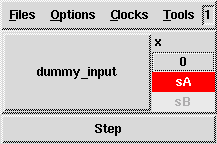
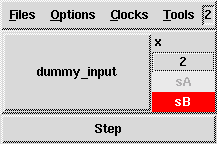
-junc_states flag which show
how the network has been duplicated.
Here, the duplicated network appears as junctions j19 and j23: